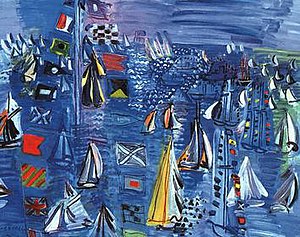
Back Paris serna AVK Paris məktəbi Azerbaijani Escola de París Catalan Pařížská škola Czech Pariserskolen Danish École de Paris (Kunst) German Σχολή του Παρισιού Greek Escuela de París (arte) Spanish مکتب پاریس Persian Pariisin koulukunta Finnish
 André Warnod, Les Berceaux de la jeune peinture (1925). Cover illustration by Amedeo Modigliani | |
| Location | France, Israel, US |
|---|---|
| Major figures | Marc Chagall, Chaïm Soutine, Yitzhak Frenkel, Jules Pascin, Amedeo Modigliani |
The School of Paris (French: École de Paris, pronounced [ekɔl də paʁi]) refers to the French and émigré artists who worked in Paris in the first half of the 20th century.
| French art history |
|---|
| Historical periods |
| French artists |
| Thematic |
| Movements |
| See also |
The School of Paris was not a single art movement or institution, but refers to the importance of Paris as a centre of Western art in the early decades of the 20th century. Between 1900 and 1940 the city drew artists from all over the world and became a centre for artistic activity. School of Paris coined by André Warnod, was used to describe this loose community, particularly of non-French artists, centered in the cafes, salons and shared workspaces and galleries of Montparnasse.[1] Many artists of Jewish origin formed a prominent part of the School of Paris and later heavily influenced art in Israel.

Before World War I the name was also applied to artists involved in the many collaborations and overlapping new art movements, between Post-Impressionists and Pointillism and Orphism (art), Fauvism and Cubism. In that period the artistic ferment took place in Montmartre and the well-established art scene there. But Picasso moved away, the war scattered almost everyone, by the 1920s Montparnasse had become a centre of the avant-garde. After World War II the name was applied to another different group of abstract artists.
- ^ "School of Paris". Heilbrunn Timeline of Art History. The Metropolitan Museum of Art. Retrieved July 16, 2014.